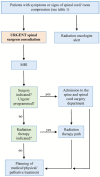The Clinical Impact of a Multidisciplinary Strategy: Diagnostic and Therapeutic Flow-Chart for Vertebral Metastases with Spinal Cord Compression
- PMID: 40361406
- PMCID: PMC12071070
- DOI: 10.3390/cancers17091479
The Clinical Impact of a Multidisciplinary Strategy: Diagnostic and Therapeutic Flow-Chart for Vertebral Metastases with Spinal Cord Compression
Abstract
Introduction: Metastatic spinal cord compression (MSCC) is a life-threatening complication caused by the involvement of the spinal cord or nerve roots. It can result in severe neurological deficits, including paralysis, sensory loss, and bladder or bowel dysfunction, significantly affecting patients' quality of life. Prompt diagnosis and intervention are critical to minimizing these outcomes and improving neurological recovery. This study evaluates the efficacy of a diagnostic and therapeutic protocol introduced at our institution in 2022, designed to enhance early detection, optimize management, and improve outcomes for patients with MSCC. Materials and Methods: The protocol was developed through a multidisciplinary collaboration involving emergency physicians, oncologists, spine surgeons, neuroradiologists, and radiation oncologists. Each specialty contributed its expertise to create a streamlined approach emphasizing early symptom recognition, rapid diagnostic imaging, and timely therapeutic interventions, such as surgical decompression and radiotherapy. To assess the protocol's effectiveness, a retrospective analysis was conducted. Clinical data from the pre-implementation period (years 2019-2021) were compared to the post-implementation period (2022-2024). Results: The implementation of the algorithm significantly improved MSCC management, increasing outpatient consultations from 671 to 828 (+23%). Comparing the pre- to post-implementation periods, emergency consultations rose from 14% to 23%, while intrahospital consultations decreased from 20% to 16%. Surgical procedures increased slightly, from 60 to 66 (+10%), including 26 emergency surgeries (+4%) and 40 elective delayed surgeries (+14%). Conclusions: The introduction of a multidisciplinary diagnostic and therapeutic protocol significantly improved outpatient management of patients with metastatic spine disease, demonstrated by a significant increase in urgent outpatient consultations and a reduction in intrahospital consultations. The number of surgical interventions for metastatic spinal cord compression slightly increased after the protocol's adoption, although the proportion of elective surgeries remained unchanged. Neurological presentation at the time of surgery did not show a statistically significant difference between the pre- and post-implementation periods. These findings highlight the protocol's effectiveness in optimizing patient flow and triaging, while further research is needed to evaluate its long-term clinical impact.
Keywords: metastatic spinal cord compression; multidisciplinary; neurological deterioration; spinal cord.
Conflict of interest statement
The authors declare no conflicts of interest.
Figures




References
-
- Verlaan J.J., Choi D., Versteeg A., Albert T., Arts M., Balabaud L., Bunger C., Buchowski J.M., Chung C.K., Coppes M.H. Characteristics of Patients Who Survived 2 Years After Surgery for Spinal Metastases: Can We Avoid Inappropriate Patient Selection? J. Clin. Oncol. 2016;34:3054–3061. doi: 10.1200/JCO.2015.65.1497. - DOI - PMC - PubMed
-
- Boussios S., Cooke D., Hayward C., Kanellos F.S., Tsiouris A.K., Chatziantoniou A.A., Zakynthinakis-Kyriakou N., Karathanasi A. Metastatic Spinal Cord Compression: Unraveling the Diagnostic and Therapeutic Challenges. Anticancer. Res. 2018;38:4987–4997. doi: 10.21873/anticanres.12817. - DOI - PubMed
LinkOut - more resources
Full Text Sources

